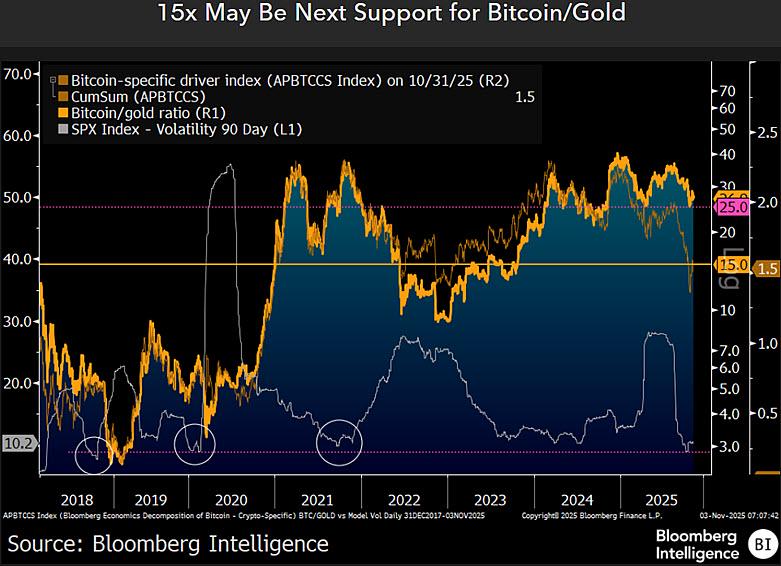Bitcoin Faces Potential 60% Decline Against Gold, Warns Bloomberg Strategist Amid Flight to Safety

A top Bloomberg strategist has issued a stark warning that Bitcoin could lose up to 60% of its value relative to gold, signaling a potential shift in investor sentiment from risk-heavy digital assets to traditional safe havens. As global economic uncertainty intensifies, with rising interest rates and market volatility pressuring speculative instruments, gold’s relative stability is once again attracting institutional attention. The forecast underscores the widening divide between digital risk assets and tangible stores of value, sparking debate over whether Bitcoin can maintain its position as “digital gold” in an era of renewed financial conservatism.
A Shift in Market Sentiment
The cryptocurrency market has witnessed considerable turbulence in recent months, with Bitcoin’s performance lagging behind traditional assets amid fears of slowing global growth and tightening monetary policies. According to Bloomberg Intelligence’s senior strategist, Mike McGlone, the digital asset’s long-term chart suggests a potential downturn, warning that Bitcoin could underperform gold by as much as 60% in the coming quarters.
This projection reflects a growing market consensus that risk-off sentiment is dominating global capital flows. Investors seeking stability have increasingly pivoted toward gold, bonds, and cash equivalents, reversing the speculative euphoria that once fueled Bitcoin’s meteoric rise.
Why Gold Is Outpacing Bitcoin
Gold’s recent resurgence highlights its enduring appeal as a time-tested hedge against uncertainty. The metal has held steady even amid rising interest rates — a period when most risk assets, including equities and cryptocurrencies, typically struggle.
Unlike Bitcoin, gold benefits from institutional confidence, physical tangibility, and centuries of historical credibility as a store of value. In contrast, Bitcoin’s volatility, speculative trading patterns, and dependence on liquidity inflows have made it vulnerable during macroeconomic tightening.
The strategist’s analysis points out that Bitcoin’s risk-adjusted returns have deteriorated, while gold has demonstrated relative resilience. “As liquidity recedes and risk appetite declines, Bitcoin’s correlation to high-beta assets increases, reducing its perceived hedge potential,” McGlone noted in his latest market commentary.
Macroeconomic Factors Driving the Divergence
Several global macroeconomic factors underpin this growing divergence between the two assets. Central banks, particularly the U.S. Federal Reserve, have adopted a more hawkish stance to curb inflation, resulting in elevated bond yields and a stronger dollar — both of which typically weigh on speculative assets.
In contrast, gold has benefited from renewed central bank demand and geopolitical uncertainty, including escalating conflicts and trade realignments. These dynamics have encouraged sovereign entities and institutional investors to rebalance portfolios toward hard assets, reducing exposure to cryptocurrencies.
Furthermore, Bitcoin’s recent price stagnation near Rs. 106,000 (approx. USD 1,270) levels and declining trading volume reflect a temporary loss of momentum as short-term investors retreat in search of stability.
The Long-Term Outlook: Bitcoin’s Identity Crisis
Bitcoin’s challenge lies not only in short-term market pressure but also in its evolving identity. Once hailed as “digital gold,” the asset now finds itself in a paradox — balancing its role as a speculative vehicle and an inflation hedge.
While its finite supply and decentralized design mirror gold’s scarcity model, Bitcoin remains highly correlated to equity markets, particularly technology stocks. This correlation undermines its claim as an independent hedge during risk-off phases.
Bloomberg’s analysis suggests that unless Bitcoin decouples from equity-style market behavior, it may continue to underperform gold and other defensive assets in the medium term.
Institutional Implications and Strategic Shifts
The warning comes as institutional investors reassess their crypto exposure. Hedge funds and family offices that once allocated to Bitcoin as an inflation hedge are now rotating back into commodities and Treasury securities.
Gold’s rising attractiveness is reinforced by central bank buying, which reached record highs in 2023. Meanwhile, Bitcoin’s mainstream integration has slowed amid regulatory tightening across major economies, including the United States and the European Union.
Nevertheless, long-term crypto proponents maintain that Bitcoin’s underlying fundamentals — such as its halving cycle in 2024 and continued network growth — could revive its momentum once macroeconomic conditions stabilize.
The Bottom Line: Gold’s Resurgence, Bitcoin’s Reckoning
The forecast of a potential 60% drop in Bitcoin’s relative value against gold does not necessarily spell the end for cryptocurrencies but rather marks a recalibration of market expectations. As risk tolerance wanes, traditional stores of value are reclaiming their dominance.
Gold’s measured ascent underscores investor preference for reliability over returns, while Bitcoin’s next phase depends on its ability to weather regulatory scrutiny, tame volatility, and regain investor trust as a long-term hedge.
For now, the market message is clear: in times of global uncertainty, the world still turns to gold — and Bitcoin, despite its promise, may have to prove itself once again as a true alternative.




